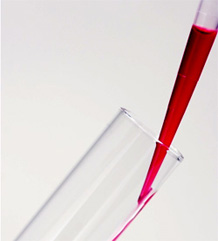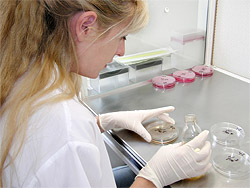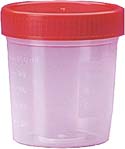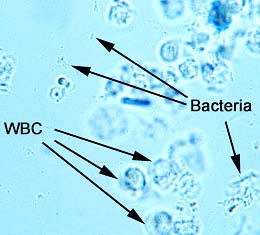Blood and Urine Testing
Looking at the results of laboratory tests done on your pet can be very confusing, overwhelming and at times, even frightening. As your pet's care giver, it is important for you to have a general understanding of laboratory tests and what their results mean. This information can be valuable when it comes to deciding medical treatment options that are available for your pet.
Generally, in order to conduct a test, a sample of your pet's blood and/or urine is collected. Once collected, it can be stored in various kinds of tubes to help preserve the sample and provide the laboratory technicians with a clean specimen.

So what does it mean when your veterinarian says she needs to run some blood work on your pet? Blood work (pre-surgical or otherwise) is usually a combination of a complete blood count (CBC) and a blood chemical analysis. Blood work is a basic evaluation tool. It also helps your veterinarian diagnose a pet's disease or monitor the progression of a disease.
The cellular elements of the blood are examined in the CBC. The CBC determines the number of erythrocytes (red blood cells), the number and type of leukocytes (white blood cells), the number of thrombocytes (platelets), the hemoglobin level and the hematocrit (packed cell volume or PCV). Erythrocytes carry oxygen throughout the body. Leukocytes fight infection and are part of the immune system. There are actually five different types of white blood cells: neutrophils, lymphocytes, basophils, eosinophils, and monocytes. Platelets are clotting proteins and can indicated how fast your pet's blood cans; slow clotting can be a serious problem. A CBC can tell your veterinarian if your pet has an unusual number of red blood cells, white cells or platelets. The numerical values for these cells can indicate if your pet's health is improving or deteriorating.
The results of a chemistry panel can indicate how well your pet's kidney and liver are functioning and the level of electrolytes in the blood. Blood chemistries are run on the fluid portion of the blood sample, not the cells in the blood. The chemistry panel usually includes the following tests, though there can be more: alkaline phosphatase (SAP, ALP), alanine transaminase (ALT), blirubin total (T Bili), blood urea nitrogen (BUN), creatinine and creatinine kinase (CK, CPK), sodium, potassium, glucose, total protein, and albumin. Alkaline phospatase, alanine transaminase, bilirubin, and albumin give your veterinarian information about your pet's liver function. Blood urea nitrogen, creatinine and creatinine kinase give your veterinarian some insight as to how well your pet's kidneys are functioning.
Below are descriptions of each indicator and what an abnormal result could possibly mean. Please note that an isolated abnormal value may not indicate a problem.
Alkaline phosphatase: Used extensively as a tumor marker, it is also present with liver injury, bone injury, pregnancy, or skeletal growth (elevated values). Growing animals have normally higher levels of this enzyme. Low levels are sometimes found in protein deficiency, malnutrition and a number of vitamin deficiencies.
Alanine transaminase: Increased levels are seen in liver damage, kidney infection, chemical pollutants, or myocardial infarction.
Bilirubin (total): Elevated in liver disease, hemolytic anemia, low levels of exposure to the sun and toxic effects to some drugs. Decreased levels are seen in people with an inefficient liver, excessive fat digestion, and possibly a diet low in nitrogen bearing foods.
Blood urea nitrogen: Increases can be caused by excessive protein intake, kidney damage, certain drugs, low fluid intake, intestinal bleeding, exercise, or heart failure. Decreased levels may be due to a poor diet, malabsorption, liver damage, or low nitrogen intake.
Creatinine: Low levels are sometimes seen in kidney damage, protein starvation, liver disease, or pregnancy. Elevated levels are sometimes seen in kidney disease due to the kidneys job of excreting creatinine, muscle degeneration, and some drugs involved in impairment of kidney function.
Glucose: Elevated in diabetes, liver disease, obesity, and pancreatitis due to steroid medications, or during stress. Low levels may be indicative of liver disease, overproduction of insulin, or hypothyroidism.
Total protein: Decreased levels may be due to poor nutrition, liver disease, malabsorption, diarrhea, or severe burns. Increased levels are seen in lupus, liver disease, chronic infections, leukemia, etc.
Albumin: High levels are rarely seen and are primarily due to dehydration. Low levels are seen in poor diets, diarrhea, fever, infection, liver disease, inadequate iron intake, third-degree burns and edemas, and hypocalcemia.

In addition to a blood test, your veterinarian may ask for a urine sample to run a urinalysis. A urinalysis can provide information about several organ systems. The concentration, color, clarity, and mircroscopic examination of the urine sample can help your veterinarian diagnose certain health problems in your pet. Urine may be obtained by catching a sample during normal urination, by passing a catheter into the bladder or by placing a small needle through the body wall into the bladder, a procedure called cystocentesis. Depending upon why the urine sample is being collected, one collection method may be preferred over another.

Urine Collection Vial
Color - Urine color will vary between species, but it is normally some shade of yellow depending on the concentration. Abnormal color changes in the urine could be due to drugs, increased urinary pigments or red blood cells. Occasionally, unusual colors may be caused by dyes associated with food or drugs.
Clarity - Urine is normally transparent. In small animals, turbidity or the lack of clarity, suggests the presence of cells, casts, or crystals. Often refrigeration will cause the sedimentation of crystals in the urine, producing a cloudy appearance. This is usually of no significance.
Odor - Urine has a characteristic smell that varies slightly by species and concentration of the sample. A particularly foul odor may occur in the presence of bacteria. Thus, strong smelling urine is common in cases of infection. Sweet smelling urine can also indicate abnormal renal function so it is always important to note any strong odor associated with your pet's urine.
pH - Urine pH will be affected by many things including the diet, handling of the sample, and acid-base balance of your pet. An alkaline pH is most indicative of an infection. Normal pH is between 6 and 8 for most animals depending on their diet.
Glucose - In the normal animal there should not be glucose in the urine. If glucose is present, it is a classic response to hyperglycemia and should instigate an investigation into the possibility of diabetes in the patient.
Ketones - In the normal animal there will be no ketones in the urine. An animal that is undergoing fat metabolism or is deficient in carbohydrates will have ketones in the urine. Ketones may also be found in the urine of malnourished animals or those with diabetes.
Sedimentation - Urine sedimentation may contain cells, casts and crystals and is examined microscopically after centrifugation of the urine sample. A very small amount of all of the above mentioned sediments is normal. Concern begins when any of these components is significantly elevated.

Urine Sediment of a Dog.
White Blood Cells and Bacteria are Shown
Protein -Finding protein in the urine can be a difficult assessment. Concentrated urine can contain small amounts of proteins. Protein in your pet's urine is generally caused by inflammation, hemorrhage or protein losing kidney disease.
Blood - There should never be blood in the urine of a normal animal. Collection methods could cause blood to appear in the urine but other causes include infection, neoplasia, or trauma.